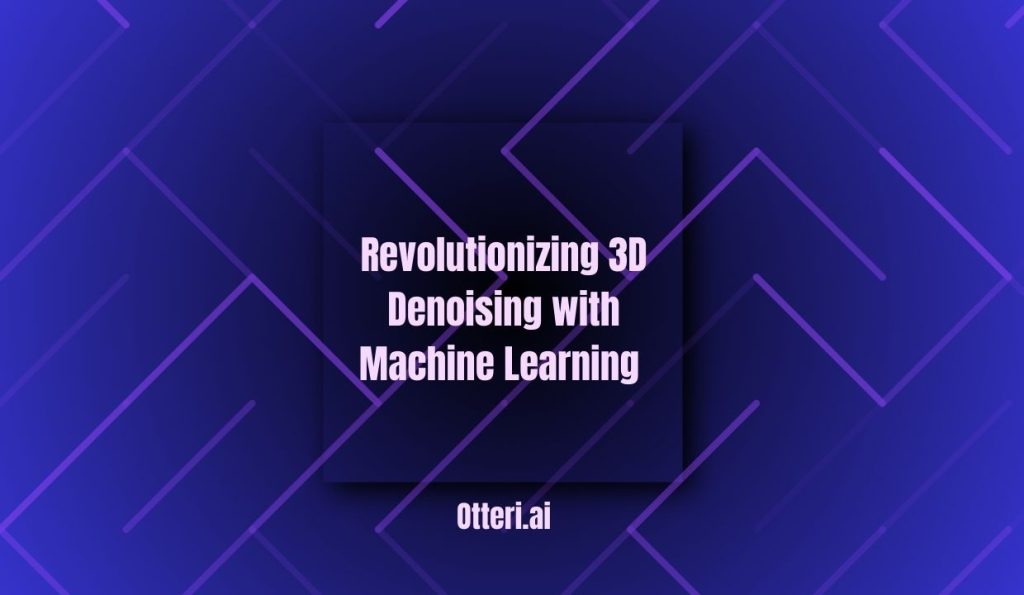
How machine learning is transforming 3D denoising in imaging, healthcare, AR/VR, and autonomous systems.
3D data plays a critical role in sectors like medical imaging, autonomous driving, virtual reality, and scientific simulations. However, 3D models and scans are often corrupted by noise due to hardware limitations, environmental interference, or data compression. Denoising — the process of removing noise while preserving meaningful structure — is a vital step in ensuring high-quality 3D data.
Traditionally, denoising relied on filtering methods like Gaussian or median filtering, or hand-crafted algorithms. But in recent years, machine learning, particularly deep learning, has redefined what’s possible. A powerful architecture at the forefront of this innovation is the Vision Transformer (ViT) — a model originally designed for 2D image classification, now adapted to handle complex 3D data with remarkable efficiency and accuracy.
In this post, we explore how ViT is changing the game in 3D denoising, the key techniques involved, and why it matters for the future of digital imaging and artificial intelligence.
What Is a Vision Transformer (ViT)?
A Vision Transformer (ViT) is a deep learning model that treats images as sequences of patches, much like how Transformers process text. Instead of using convolutions like CNNs, ViTs divide images into patches (e.g., 16×16 pixels), flatten them, and feed them through a Transformer architecture — enabling them to capture long-range dependencies and contextual relationships.
When extended to 3D, ViTs work on 3D voxel grids, point clouds, or multi-view representations, making them ideal for denoising tasks where noise can be spatially inconsistent or structurally complex.
Why Use ViT for 3D Denoising?
The advantages of using Vision Transformers in 3D denoising include:
Global Attention Mechanisms: ViTs capture relationships between distant parts of the 3D structure, which is especially useful for removing dispersed noise patterns.
Parameter Efficiency: Unlike CNNs that grow in complexity with depth, ViTs scale better with fewer parameters.
Flexibility Across Domains: ViTs can be pretrained on large datasets and fine-tuned for specific tasks like CT scan denoising, LiDAR noise removal, or mesh cleanup.
Techniques for 3D Denoising Using ViT
1. Patch-based Representation in 3D
Just like in 2D, 3D data can be divided into volumetric patches (e.g., 16x16x16 voxels). Each patch is treated as a token in the transformer model. This allows the network to understand spatial context across multiple dimensions.
2. Positional Encoding in 3D Space
Transformers lack an innate understanding of order, so positional encodings are crucial. For 3D data, encodings must represent x, y, and z coordinates accurately to help the model distinguish between spatial locations.
3. Pretraining on Synthetic Noise
Models are often pretrained on synthetic 3D noise — like Gaussian or salt-and-pepper — added to clean datasets (e.g., ShapeNet, ModelNet40). This enables ViT to learn general noise patterns before being fine-tuned on real-world datasets.
4. Hybrid Architectures
Many state-of-the-art solutions combine CNNs and ViTs. CNNs handle local patterns while ViTs focus on global features. This hybrid approach is particularly effective in medical imaging where preserving edges and structures is critical.
Applications of 3D Denoising with ViT
1. Medical Imaging (MRI, CT Scans)
Medical scans are often degraded by motion artifacts or low-dose imaging. ViT-based denoising helps reconstruct clean images without losing anatomical details, leading to better diagnosis and treatment planning.
2. Augmented and Virtual Reality
In AR/VR, noisy depth maps or point clouds can disrupt user immersion. ViT-powered denoising smoothens these inputs, improving rendering accuracy and interaction responsiveness.
3. Autonomous Vehicles
3D LiDAR and radar data is prone to noise from reflections or weather. Denoising ensures accurate perception for safe navigation and object detection.
4. 3D Printing and Manufacturing
Noisy 3D scans of real-world objects can result in flawed 3D prints. ViT models help produce cleaner mesh reconstructions, ensuring better quality in additive manufacturing.
Challenges and Future Directions
High Computational Cost
Transformers require significant compute resources, especially for high-resolution 3D data. Efforts are underway to optimize ViT with sparse attention mechanisms and efficient patching strategies.
Limited Labeled 3D Datasets
Training ViT models from scratch on 3D data demands large annotated datasets. Semi-supervised learning, transfer learning, and synthetic data generation are promising solutions.
Real-time Performance
For robotics and autonomous systems, latency matters. Lightweight ViT variants like Swin Transformer or MobileViT are being explored to meet real-time requirements without sacrificing quality.
Tools and Frameworks Supporting 3D ViT Denoising
PyTorch3D: For 3D data processing and rendering.
Hugging Face Transformers: Offers ViT models that can be fine-tuned for 3D tasks.
Open3D: For handling point cloud data.
Monai: Specialized in medical imaging, supports ViT integrations.
The fusion of machine learning with 3D data is unlocking breakthroughs across industries, and Vision Transformers are at the center of this transformation. Their ability to model long-range dependencies and adapt to volumetric data makes them ideal for 3D denoising — enabling sharper visuals, better insights, and safer autonomous systems.
As research advances, expect to see faster, more lightweight ViT architectures and a surge in real-world applications. Whether you’re a developer, data scientist, or researcher, now is the time to explore the power of ViT for 3D denoising.
Ready to share cutting-edge tech insights like this?
Use Otteri.ai to turn complex topics into engaging, SEO-friendly content in minutes. Whether you’re writing about AI, machine learning, or the future of 3D technology, Otteri helps you publish smarter, faster.
Start creating today at Otteri.ai — where AI meets effortless content.